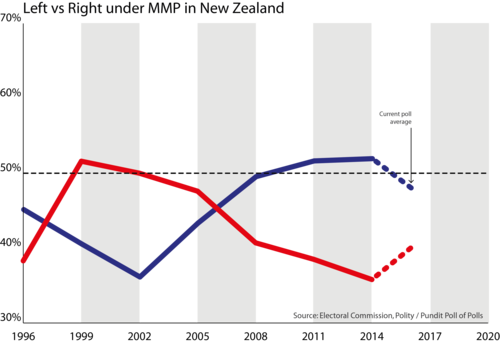This afternoon I watched Labour and the Greens announce their signed Memorandum of Understanding to cooperate in changing the government.
Good for the leaderships of both parties for putting this together. I’ve always been a Labour person, but if I couldn’t vote Labour I’d vote Green. I think Labour and the Greens are the core of New Zealand’s next government.
I’m sure there’ll be a lot of commentary about this. I just want to add two points.
The first is about timing – this is the right time for two genuinely progressive forces to cooperate more deeply. As the chart below shows, the combined left* is now rising off its historic lows, while the combined right** is falling from its historic highs.
At present, the right is polling around 48%, the left around 40%, and New Zealand First has around 10%. Since the last election the left is rising while the right is falling. We’re right at the bottom of the range where the right can be re-elected on its own. With any further poll movement over the next 15 months, it will be not be clear on election night 2017 who the Prime Minister will be.
The progressive left is now back in the game.
That makes it the right time for the left to cooperate, with the aim of consolidating the current positive trend and making the opinion change faster.

It’s no surprise that after eight years the National government is being increasingly blamed for the serious problems we’re facing as a country. Whether it’s the many parts of the housing omnishambles, growing problems in health and education, and an economy that’s delivering big gains for just a few and not much for most of us, the public appetite for more of the same is diminishing.
Today’s Labour / Greens announcement helps grow the other side of that equation, which is about hope and optimism about an alternative government. Which leads me to my second point: What is the value of this kind of agreement?
Even though it is not a Coalition Agreement, the Labour / Green MOU is a clear, formal signal to voters about the progressive left working together to deliver an alternative vision. There’s a stream of academic research about this, most prominent in Sona Golder’s (2006) book The Logic of Pre-Electoral Coalition Formation. That research provides evidence that parties who cooperate before an election, rather than campaign completely independently, ultimately are more likely to win government. That’s a pretty good reason to formalize things.
This MOU is not a full on pre-electoral coalition, of course, and speaking personally I’d be surprised if these particular parties went there this term. Ultimately the voters deal the cards when they vote, and it’s tricky for a party to play its hand when there’s so much uncertainty over who’ll get which cards.
But the academic research suggests moves to provide voters with more certainty and more unity in a potential governing coalition tends to get rewarded at the polls. Sometimes, and most strongly, that’s a pre-electoral coalition. But an MOU achieves at least some of the same goals as a coalition agreement, and so we’d expect at least some of the same electoral rewards.
And that’s a second reason why the leaderships have done so well to put this MOU together now.
* Combined Left is Labour / Alliance when around / Greens
** Combined right is National / ACT / UF when not polling zero / Christian movement de jour